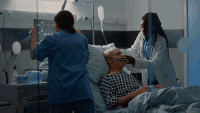In this interview conducted by Terry Ratner, RN, MFA, Pam Cipriano gives her perspective on the major issues facing the nursing profession. Dr. Cipriano is Chief Clinical Officer and Chief Nursing Officer at the University of Virginia Health System in Charlottesville. Besides overseeing more than 3,000 employees, she serves as Clinical Associate Professor of Nursing. Throughout her 30 years of clinical practice, teaching, and ongoing research, Dr. Cipriano has set herself apart as a leader. Describing her role on American Nurse Today, she states, “I’m honored by the opportunity to serve as Editor-in-Chief. It’s an incredible opportunity to give back to my profession.”
What are the top three issues facing nurses today?
First and foremost, we need to ensure a nursing workforce for the future. We must focus on preparing, recruiting, and retaining nurses. This involves a cascade of issues: faculty shortages, retirements, availability of educational programs, and improving the work environment. Also, we need to ensure the longevity of our seasoned nurses and implement changes to make the workplace safe for them. As nurses age, some of us are prone to injury or lack the stamina to continue working 12-hour shifts. We need to examine what motivates and retains nurses of all ages, and create more flexible work options.
Secondly, we need to set goals to help more nurses continue their formal education. Two-thirds of the nursing workforce have associate degrees, which may not be sufficient to bring us into the future. I say this even in the face of a nursing shortage, because we’re realizing that nurses are at the forefront in problem solving, planning, and providing care in many settings. We collaborate with—and want to assume leadership roles within—the healthcare team, which includes providers with advanced degrees. At the same time, we must ensure the public that we have sufficient education to advise, teach, understand patients’ needs, and deliver sophisticated care.
The third issue we face is keeping up with the technology boom. Technology fuels much of the work nurses do, whether it involves changes in the tools that affect patient interventions or in automating the work environment. Examples include the mandate for safer medication administration systems, electronic health records, automated patient teaching tools, and hands-free voice communication tools. To advance the nursing profession, we must embrace technology and leverage its use as the healthcare environment evolves.
Where do you stand on educational requirements for nurses to enter the practice?
The debate on whether to establish a single entry level for nursing has been going on for 50 years, and focuses predominantly on the baccalaureate degree. I’m a firm believer in higher education for nurses.
It prepares them for their role as nurses, enabling them to learn not only technical skills but also collaboration, analysis of complex patient problems, and determination of the best patient interventions.
I’m a diploma graduate who went back to school right away for a bachelor’s degree, then a master’s and, finally, a doctorate. So I understand the importance of having as much education as possible. As a clinical nurse specialist, manager, and administrator, I’ve observed over the years an identifiable difference among nurses based on their educational preparation. The more education a nurse has, the greater the ability to look at the whole picture and think of the ramifications of immediate and long-term actions beyond the particular situation.
I support baccalaureate preparation as the entry-level educational requirement. I recognize and value the significant contribution that associate-degree nurses make to the profession, and would like to see them continue their education to the next level. To improve nursing practice and the nursing profession, we all have a responsibility to help nurture and support nurses to pursue the next degree.
I also favor preparing more nurses at the master’s and doctorate levels. We’re competing on the healthcare policy front for recognition and reimbursement; the only way to accomplish this is to have thoughtful, highly educated leaders at the forefront. As we face yet another growing nursing shortage, we’re advocating at the state and national levels on behalf of the 2.5 million practicing nurses—staff nurses, advanced practice nurses, educators, researchers, and administrators. Nurses aspire to gain more knowledge, so supporting each group and encouraging continued education is crucial to the future success of our profession.
What creative approaches can we use to address the nursing faculty shortage?
Many healthcare organizations are sharing their clinical nursing experts with local nursing schools. It’s not uncommon for senior nurses from specific hospitals to serve as instructors for students during their clinicals. These instructors are valuable to the educational community because they’re grounded in their nursing practice and provide a “real life” experience for students.
Perhaps we can devise other ways to create teaching teams of seasoned nurses so that they partner with doctorally prepared faculty to assist in teaching. The faculty person would oversee the curriculum while the seasoned nurse provides clinical assistance and additional classroom lectures.
Of course, there’s no substitute for financial support that encourages nurses to further their education so they can teach in a university setting. Federal and state funding has provided assistance for nurses who want to obtain the degrees needed for teaching. Also, masters and doctorate nursing programs have moved into distance learning faster than other nursing programs, and this has encouraged many nurses to seek higher degrees. Distance learning is vital because it requires little onsite presence.
To what extent has evidence-based practice (EBP) been implemented in most hospitals?
Only about 15% of healthcare providers use EBP when making clinical decisions. The good news is we’ve been able to demystify EBP. In nursing school, we were taught to use the nursing process, which mirrors the scientific method. When assessing a particular nursing practice, we collect and analyze data to understand the issues around that practice, identify desired or expected outcomes, create and implement a plan to change practice and thus achieve the desired outcomes, evaluate the results, and determine if outcomes have been achieved. We do this repeatedly in customizing care for any patient.
Nurses can get excited when they examine bedside practices and look for ways to improve care by applying research findings. My facility has a mentored research program and a practice committee that focuses on EBP. Once a year, our nursing staff celebrates EBP with 2 hours of presentations engineered by staff and mentored by senior staff and faculty. The presentations reflect how and why we’ve changed practice. Staff review the underlying principles, theories, and findings from the literature and identify the application of this information or new findings from our own research to changes in how we practice nursing in our facility. That’s how we build the most up-to-date care with a scientific base.
Having research data that reflect decisions about practice is becoming a natural part of nursing. The goal is to spread EBP standards within healthcare facilities. Of course, at Magnet™ facilities, EBP is an expectation for demonstrating excellence in practice.
How can nurse-leaders better involve staff nurses in decision-making and strategic planning?
Nurse-leaders have the responsibility to involve staff, whether it’s through formal strategic planning or involvement in committees that make key decisions. If we want to change a particular nursing intervention or introduce new technology, we need to include staff nurses in the decision process. As frontline care providers and innovators of change, staff nurses can identify pitfalls and opportunities to transform the workplace. They need to be recognized and valued as they share decision-making responsibilities. For any Magnet facility, this is a necessity.
The most successful organizations cultivate a solid relationship between nurse-managers and staff to create an environment of collaboration and mutual support. Bringing together the new ideas of staff nurses with managers who can obtain the resources needed to pave the way for change is a formidable way to transform practice and improve patient care.

















